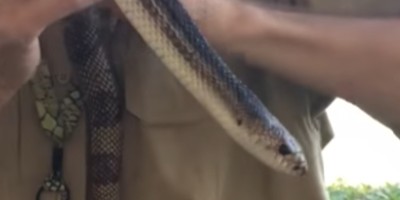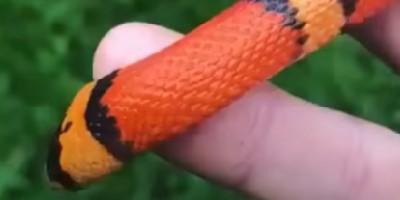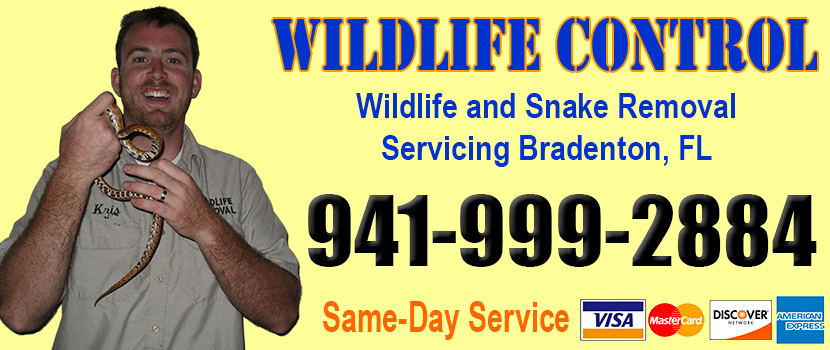
Welcome to bradentonsnakes.com! I am David, a snake enthusiast living in Bradenton, FL. Many people don't know that Bradenton is in fact full of snakes! You just need to know where to find them - they can often be shy and elusive. Some Florida snake species are more common outside of the city limits, in different parts of Manatee County FL, but many types of snakes are indeed common in the more urban parts of Bradenton. This guide is meant to help educate you about the beautiful snakes of Bradenton, and to help you identify the most common snakes of Bradenton, as well as the venomous snakes of Bradenton that you should learn to recognize and avoid. If you want more detail, click here for my complete list of ALL snake species in Bradenton. Remember the following:
- Most snakes of Bradenton are harmless and don't want to encounter you
- Venomous snakes exist but are uncommon in Bradenton, Florida
- Snakes eat rats and mice and are a valuable part of the Florida ecosystem
- Never kill a snake - if you leave a snake alone, it will leave you alone.
Common Snake Species in Bradenton
 Florida brown snake:
Florida brown snakes are small, thin snakes measuring about 9 to 13 inches as adults. Their skin is rusty or tarnished brown with a light stripe running down the backs of adults. On each side of the light stripe are parallel rows of little black spots. Florida brown snakes commonly reside in wetlands and terrestrial habitats. They are commonly found under rocks, leaf litter, and under covered surfaces. They can also reside in suburban areas that were previously forested areas. Their diets consist mainly of earthworms, slugs, and sometimes they can eat insects too. They are not constrictors, they grab prey quickly and swallow while still alive. Florida brown snakes are non-venomous and do not bite. When threatened, they can release a pungent odor from 2 glands located at the end of their tail.
Florida brown snake:
Florida brown snakes are small, thin snakes measuring about 9 to 13 inches as adults. Their skin is rusty or tarnished brown with a light stripe running down the backs of adults. On each side of the light stripe are parallel rows of little black spots. Florida brown snakes commonly reside in wetlands and terrestrial habitats. They are commonly found under rocks, leaf litter, and under covered surfaces. They can also reside in suburban areas that were previously forested areas. Their diets consist mainly of earthworms, slugs, and sometimes they can eat insects too. They are not constrictors, they grab prey quickly and swallow while still alive. Florida brown snakes are non-venomous and do not bite. When threatened, they can release a pungent odor from 2 glands located at the end of their tail.  Florida pine snake:
The Florida pine snake is a large snake. In fact, it is regarded as one of the largest snakes in the entire country. Adults can grow up to 84 inches in length. The snake is typically brown and has dark blotches around its back. The scales on its skin are rigid and its small head has a pointed snout. Florida pine snakes are found in areas where pine and scrub oaks are abundant. They can also be found in sandhill habitats, wooded areas, and abandoned fields. They may use burrows made by other animals as shelter. Their diet mainly consists of rabbits, moles, rats, squirrels, smaller snakes, etc. Florida pine snakes are non-venomous and are not dangerous to humans and pets. They can however bite if threatened.
Florida pine snake:
The Florida pine snake is a large snake. In fact, it is regarded as one of the largest snakes in the entire country. Adults can grow up to 84 inches in length. The snake is typically brown and has dark blotches around its back. The scales on its skin are rigid and its small head has a pointed snout. Florida pine snakes are found in areas where pine and scrub oaks are abundant. They can also be found in sandhill habitats, wooded areas, and abandoned fields. They may use burrows made by other animals as shelter. Their diet mainly consists of rabbits, moles, rats, squirrels, smaller snakes, etc. Florida pine snakes are non-venomous and are not dangerous to humans and pets. They can however bite if threatened.
 Blue-striped garter snake:
Adults of this snake species usually measure about 18 to 26 inches in length. Their slender bodies usually have 3 brightly colored stripes, yellow, blue, or white that run all across them. In adults, the skin is usually black or grey although some subspecies can be greenish-brown. Some individuals may lack the stripes and may have a checkered pattern instead. Blue-striped garter snakes are found in hardwoods, marshes, pinelands, and typically any place that is wet. They can also survive in suburban areas where forests were formally present. Their diet consists of frogs, snails, freshwater fishes, and small mammals and birds. They are not constrictors so they merely grab prey with their jaws and try to swallow it alive as quickly as possible. Blue-striped garter snakes are non-venomous and do not pose a threat to humans and pets. When threatened, the snake will typically flee and will only bite as a last resort. They can also release a foul-smelling musk from the glands located on their tails to wade off intruders.
Blue-striped garter snake:
Adults of this snake species usually measure about 18 to 26 inches in length. Their slender bodies usually have 3 brightly colored stripes, yellow, blue, or white that run all across them. In adults, the skin is usually black or grey although some subspecies can be greenish-brown. Some individuals may lack the stripes and may have a checkered pattern instead. Blue-striped garter snakes are found in hardwoods, marshes, pinelands, and typically any place that is wet. They can also survive in suburban areas where forests were formally present. Their diet consists of frogs, snails, freshwater fishes, and small mammals and birds. They are not constrictors so they merely grab prey with their jaws and try to swallow it alive as quickly as possible. Blue-striped garter snakes are non-venomous and do not pose a threat to humans and pets. When threatened, the snake will typically flee and will only bite as a last resort. They can also release a foul-smelling musk from the glands located on their tails to wade off intruders.
Venomous Snake Species in Bradenton
 Southern copperhead:
Southern copperheads, like all copperhead snakes, belong to the pit viper family. Adults can reach 24 to 26 inches in length. The skin generally appears rough and its body has dark patterned crossbands in the shape of an hourglass. The crossband is narrowed at the back of the snake and wider towards the base. There are pits located on either side of its face between the eyes and nostrils hence the name pit viper. These pits are used in heat sensing when the snake is looking for prey. Southern copperheads live in wooded lowlands, leaf litter, and animal burrows under branches and logs. They can also live in wooded suburbs close to humans. They feed on mice, rats, frogs, insects, and smaller snakes. These snakes are diurnal, mainly active during the day around spring and nocturnal during the summer. Southern copperheads eat only once in 3 weeks during the active months. The southern copperhead, like all pit vipers, is venomous. Although the bite is rarely fatal due to the short fangs possessed by the snake, they often lie under dead leaves waiting for prey. They do not move very fast but they can strike when threatened.
Southern copperhead:
Southern copperheads, like all copperhead snakes, belong to the pit viper family. Adults can reach 24 to 26 inches in length. The skin generally appears rough and its body has dark patterned crossbands in the shape of an hourglass. The crossband is narrowed at the back of the snake and wider towards the base. There are pits located on either side of its face between the eyes and nostrils hence the name pit viper. These pits are used in heat sensing when the snake is looking for prey. Southern copperheads live in wooded lowlands, leaf litter, and animal burrows under branches and logs. They can also live in wooded suburbs close to humans. They feed on mice, rats, frogs, insects, and smaller snakes. These snakes are diurnal, mainly active during the day around spring and nocturnal during the summer. Southern copperheads eat only once in 3 weeks during the active months. The southern copperhead, like all pit vipers, is venomous. Although the bite is rarely fatal due to the short fangs possessed by the snake, they often lie under dead leaves waiting for prey. They do not move very fast but they can strike when threatened.
 Eastern coral snake:
Eastern coral snakes sometimes seen in Sarasota are medium-sized and slender snakes, with adults reaching between 18 and 30 inches in length. The scales on their skin are smooth with anal plates divided. They are brightly colored with patterns of red, yellow, and black rings touching each other. Eastern coral snakes are found in all areas of Florida. They live around hardwoods, pine, and sandhill habitats. They are great at hiding and are rarely seen. They spend most of their days hiding underground. They prey on lizards and other snakes, killing them by destabilizing them with their venom. Eastern coral snakes are venomous, although bites rarely cause death in humans. This is because the eastern coral snakes have a poor delivery system and they literally have to chew on their prey before they can release their venom. Coral snakes are the only snake species that possess fixed fangs in the front of their mouths.
Eastern coral snake:
Eastern coral snakes sometimes seen in Sarasota are medium-sized and slender snakes, with adults reaching between 18 and 30 inches in length. The scales on their skin are smooth with anal plates divided. They are brightly colored with patterns of red, yellow, and black rings touching each other. Eastern coral snakes are found in all areas of Florida. They live around hardwoods, pine, and sandhill habitats. They are great at hiding and are rarely seen. They spend most of their days hiding underground. They prey on lizards and other snakes, killing them by destabilizing them with their venom. Eastern coral snakes are venomous, although bites rarely cause death in humans. This is because the eastern coral snakes have a poor delivery system and they literally have to chew on their prey before they can release their venom. Coral snakes are the only snake species that possess fixed fangs in the front of their mouths.
If you're unsure, you can email me a photo of the snake at info@bradentonsnakes.com and I will email you back with the snake's species. If you found a snake skin, read my Found a Skin? page, and you can email me a photo of the skin, and I'll identify the snake for you. If you need professional Bradenton snake removal help, click my Get Help page, or see the below website sponsor I found, who provides that service.
Remember, the term is not poisonous snakes of Bradenton, it's venomous snakes of Bradenton. Poison is generally something you eat, and venom is injected into you. That said, dangerous snakes are very rare in Bradenton. The few venomous snakes of Manatee County are rarely seen. But they are commonly misidentified, so learn about all the snake species of Bradenton in order to correctly identify them. These snakes are usually also found in the surrounding towns of Sarasota, Palmetto, Lakewood Ranch, Ellenton, Holmes Beach, Anna Maria, Bradenton Beach, Cortez, West Bradenton, Bayshore Gardens, Whitfield, South Bradento, Samoset, West Samoset, Memphis, and the surrounding areas.
Read our article about:
Proper Way of Snake Handling
bradentonsnakes.com domain and hosting costs made possible by the generous support of this sponsor:
